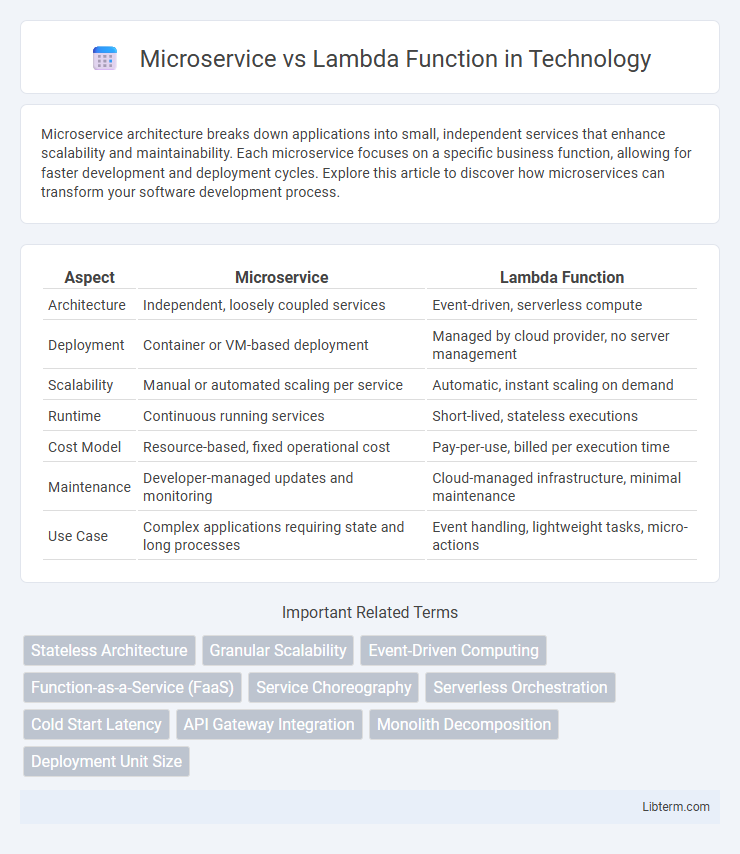Microservice architecture breaks down applications into small, independent services that enhance scalability and maintainability. Each microservice focuses on a specific business function, allowing for faster development and deployment cycles. Explore this article to discover how microservices can transform your software development process.
Table of Comparison
| Aspect | Microservice | Lambda Function |
|---|---|---|
| Architecture | Independent, loosely coupled services | Event-driven, serverless compute |
| Deployment | Container or VM-based deployment | Managed by cloud provider, no server management |
| Scalability | Manual or automated scaling per service | Automatic, instant scaling on demand |
| Runtime | Continuous running services | Short-lived, stateless executions |
| Cost Model | Resource-based, fixed operational cost | Pay-per-use, billed per execution time |
| Maintenance | Developer-managed updates and monitoring | Cloud-managed infrastructure, minimal maintenance |
| Use Case | Complex applications requiring state and long processes | Event handling, lightweight tasks, micro-actions |
Introduction to Microservices and Lambda Functions
Microservices are a software architecture style that structures applications as a collection of loosely coupled, independently deployable services, each responsible for specific business functionalities. Lambda functions, offered by cloud providers like AWS Lambda, are serverless compute services that run small units of code in response to events without the need for managing infrastructure. Both microservices and Lambda functions enable modular development and scalability, but microservices focus on designing full-fledged services, whereas Lambda functions emphasize event-driven, fine-grained code execution.
Core Concepts: Microservices Explained
Microservices architecture divides applications into independent, self-contained services that communicate through APIs, enabling scalability and agile development. Each microservice focuses on a specific business functionality and can be developed, deployed, and maintained independently. This modular approach contrasts with monolithic designs by promoting flexibility, fault isolation, and technology diversity within an application ecosystem.
Core Concepts: Lambda Functions Explained
Lambda functions are lightweight, event-driven pieces of code designed to run specific tasks in response to triggers, with automatic scaling and no server management required. Unlike microservices, which are independently deployable services with their own distinct business logic and infrastructure, lambda functions operate as ephemeral units that execute short-lived processes within cloud environments. Their core concept revolves around simplicity and efficiency, often utilized in scenarios requiring real-time data processing and on-demand execution.
Key Differences Between Microservices and Lambda Functions
Microservices are independently deployable services that encapsulate specific business capabilities and run within a dedicated runtime environment, enabling scalability and fault isolation. Lambda functions, as serverless compute services provided by platforms like AWS Lambda, execute discrete units of code triggered by events without the need for server management, optimized for short-lived, stateless operations. Key differences include microservices' persistent state and broader scope versus Lambda functions' ephemeral execution, cost efficiency through pay-per-use, and seamless auto-scaling based on event-driven triggers.
Scalability in Microservices vs Lambda Functions
Microservices enable scalability by allowing individual components to be deployed and scaled independently, optimizing resource allocation based on demand. Lambda functions offer automatic scaling, instantly handling workload spikes by executing code in response to events without manual intervention. While microservices require infrastructure management for scaling, Lambda functions provide seamless, event-driven scalability ideal for variable workloads.
Deployment and Maintenance Considerations
Microservices are independently deployable services with dedicated infrastructure, allowing precise control over deployment cycles and scalability tailored to specific business functionalities. Lambda functions operate as event-driven, stateless functions managed by cloud providers, offering simplified deployment without server management but limited customization and state control. Maintenance of microservices involves managing multiple service lifecycles and infrastructure, while Lambda functions reduce operational overhead through automated scaling and patching but require careful monitoring of function cold starts and execution limits.
Cost Implications: Microservices vs Lambda Functions
Lambda functions offer a pay-as-you-go pricing model, charging only for actual compute time and resources used, which can significantly reduce costs for event-driven applications with irregular workloads. Microservices typically involve continuous resource allocation and operational overhead, leading to higher fixed costs associated with infrastructure, maintenance, and scaling. Choosing Lambda functions can optimize costs by eliminating idle resource expenses, whereas microservices may incur greater expenses due to persistent resource consumption and management complexity.
Use Case Scenarios and Best Practices
Microservices are ideal for complex, scalable applications requiring independent deployment and long-lived processes, such as e-commerce platforms or banking systems. Lambda functions excel in event-driven, short-lived tasks like real-time file processing, data transformation, or API request handling due to their serverless nature and automatic scaling. Best practices for microservices include defining clear service boundaries and using API gateways, while for Lambda functions, optimizing cold start times and managing stateless code enhance performance.
Security Concerns and Compliance
Microservices require comprehensive security measures such as robust authentication, authorization, and network segmentation to protect inter-service communication and data integrity. Lambda functions, while benefiting from minimal infrastructure management, face challenges in securing ephemeral environments and ensuring compliance with data handling policies due to their stateless nature and shared execution context. Both architectures must adhere to stringent compliance standards like GDPR and HIPAA by implementing encryption at rest and in transit, detailed audit logging, and regular vulnerability assessments to mitigate risks effectively.
Choosing the Right Architecture for Your Application
Selecting the right architecture depends on application requirements such as scalability, deployment speed, and resource optimization. Microservices excel in complex, stateful applications requiring independent scaling and continuous deployment, while Lambda functions offer serverless, event-driven execution ideal for short-lived, stateless tasks with automatic scaling. Evaluating factors like operational overhead, cost efficiency, and integration complexity ensures an optimal choice between microservice and Lambda function architectures.
Microservice Infographic

 libterm.com
libterm.com